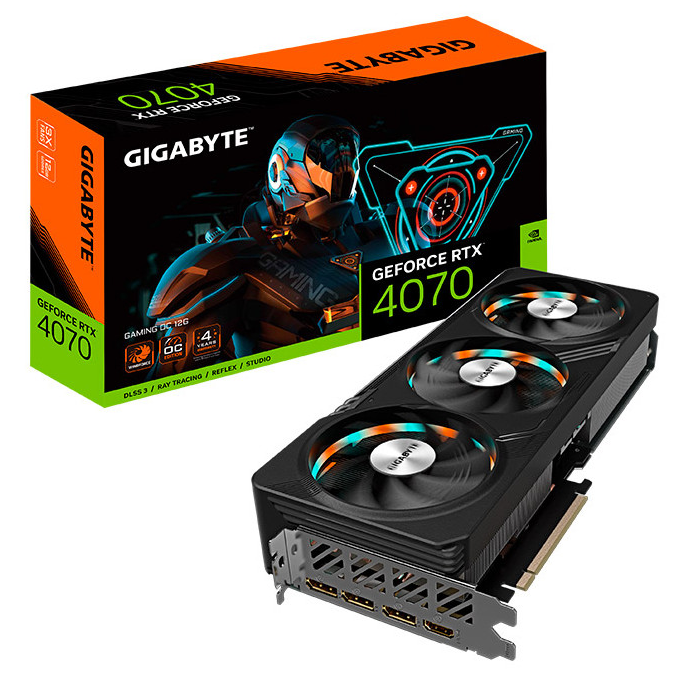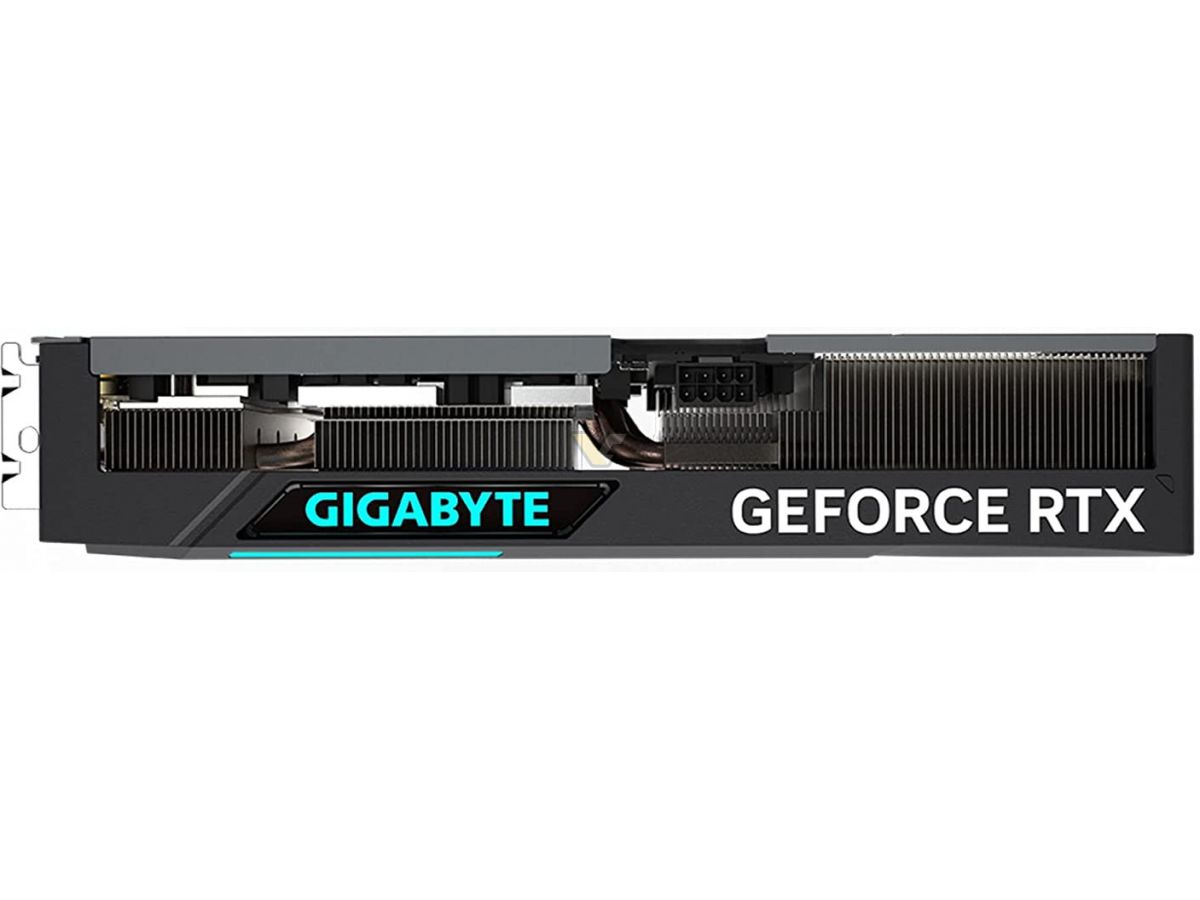More RTX 4070 Designs Show Up: Gigabyte, Palit, MSI, Zotac
The official launch of Nvidia's GeForce RTX 4070 graphics card is allegedly a few days away, so we are not surprised by the surplus of images of yet-to-be-announced add-in-boards featuring the cut-down AD104 'Ada Lovelace' GPU shown by momomo_us, alexwifi42 and Italian vendor Drako.it (and found by our colleagues at VideoCardz).
On the specifications side of matters, images of GeForce RTX 4070 graphics cards by Gigabyte, Palit, MSI, and Zotac show us nothing new, as we already know from the leaks (which should be taken with a grain of salt, yet at this point they are more than likely to be accurate) that these AIBs carry a cut-down AD104 graphics processor with 5,888 CUDA cores and paired with 12GB of GDDR6X memory.














Gigabyte is prepping four GeForce RTX 4070 graphics card designs, with only the WindForce and Eagle models shipping with standard 8-pin auxiliary PCIe power connectors, while the Gaming and Aero models will have 12VHPWR 16-pin connectors. All four designs will have three fans, based on the leaked images.
One of the things that strikes the eye with the pictures of the upcoming GeForce RTX 4070 graphics cards from Gigabyte, Palit, MSI, and Zotac is that most of them are triple-wide with a massive cooling system, just as my colleague Mark reported yesterday about the hoard of MSI's GeForce RTX 4070 AIBs.
While it is not particularly surprising that many of GeForce RTX 4070-based graphics cards will be huge, considering the overclocking potential of the GPU that powers them, it is reasonable to expect more compact AIBs too. This is perhaps where MSI's GeForce RTX 4070 Ventus 2X comes into play. The board features a dual-fan two-wide cooling system and will likely fit into most of PCs used by gamers. Of course, different GeForce RTX boards feature different power connections, some keep using well-proven eight-pin plugs, while others employ the all-new 12VHPWR.
Apparently, budget-friendly options from Zotac and Palit will also have dual-fan designs and 12GB of GDDR6X memory, yet take the information with a grain of salt as this comes from unofficial sources.
| Row 0 - Cell 0 | GPU | FP32 CUDA Cores | Memory Configuration | TBP | MSRP |
| GeForce RTX 4090 Ti | AD102 | 18176 (?) | 24GB 384-bit 24 GT/s GDDR6X (?) | 600W (?) | ? |
| GeForce RTX 4090 | AD102 | 16384 | 24GB 384-bit 21 GT/s GDDR6X | 450W | $1,599 |
| GeForce RTX 4080 | AD103 | 9728 | 16GB 256-bit 22.4 GT/s GDDR6X | 320W | $1,199 |
| GeForce RTX 4070 Ti | AD104 | 7680 | 12GB 192-bit 21 GT/s GDDR6X | 285W | $799 |
| GeForce RTX 4070* | AD104 | 5888 (?) | 12GB 192-bit 21 GT/s GDDR6X | 250W (?) | $599 (?) |
| GeForce RTX 4060 Ti* | AD106 | 4352 (?) | 8GB 128-bit 18 GT/s GDDR6 | 160W (?) | <$500? |
Get Tom's Hardware's best news and in-depth reviews, straight to your inbox.

Anton Shilov is a contributing writer at Tom’s Hardware. Over the past couple of decades, he has covered everything from CPUs and GPUs to supercomputers and from modern process technologies and latest fab tools to high-tech industry trends.
-
PlaneInTheSky The massive size of supposed "midrange" GPU is bothersome from an architectural standpoint. GPU are basically complete PC at this point. You're not buying a GPU, you're buying a second PC.Reply
This impacts not only size, but adds cost and complexity to PC hardware. It also impacts performance, with PC struggling to keep up with consoles in many games due to data and VRAM bottlenecks. DirectStorage is a bandaid on PC, it is not a real solution.
The Playstation 5 is a monster in the speed it can transfer data. This has nothing to do with its individual components, but everything with its unified architecture, shallow software stacks and the resulting speed at which its components can talk to each other.
PC will need to move to a unified architecture and cooling solution at some point soon to stay competitive. Consoles, servers and mobile devices are already there. -
atomicWAR ReplyPlaneInTheSky said:The massive size of supposed "midrange" GPU is bothersome from an architectural standpoint. GPU are basically complete PC at this point. You're not buying a GPU, you're buying a second PC.
This impacts not only size, but adds cost and complexity to PC hardware. It also impacts performance, with PC struggling to keep up with consoles in many games due to data and VRAM bottlenecks. DirectStorage is a bandaid on PC, it is not a real solution.
The Playstation 5 is a monster in the speed it can transfer data. This has nothing to do with its individual components, but everything with its unified architecture, shallow software stacks and the resulting speed at which its components can talk to each other.
PC will need to move to a unified architecture and cooling solution at some point soon to stay competitive. Consoles, servers and mobile devices are already there.
GPUs are not secondary PCs...not even close. I hate when folks say this as it simply is not true. Then calling direct storage a band-aid but to then go on to praise PS5's SSD speeds in the same breath... something my PC can easily tie or beat. Hypocritical much? They serve the same exact purpose on their respective platforms. So praising one while decrying the other is like the kettle calling the pot black.
And thats before we get into your comments on how x86-64 needs to be more like Apple. There are advantages to a unified arch with Intel and AMD makes strides as of late but it also has some huge short comings as of now. Gaming performace is limited due to silicon budgets on monolethic chips. Just look at Apples claimed GPU performance to reality. The two do not line up and in the case if their ultra chips, tend to stutter due cross package communication/latency. For now I find true MCM GPUs to be lacking like Apples and their best single SOC solutions are far weaker than PC options.
My bigger issue is nearly every day I see you post how horrid PC is some fashion to then champion the gaming console or Apple. I just don't get it. They all have a place and purpose. If you're so bent on PC...why bother posting on Toms? -
dogchow ReplyPlaneInTheSky said:The massive size of supposed "midrange" GPU is bothersome from an architectural standpoint. GPU are basically complete PC at this point. You're not buying a GPU, you're buying a second PC.
This impacts not only size, but adds cost and complexity to PC hardware. It also impacts performance, with PC struggling to keep up with consoles in many games due to data and VRAM bottlenecks. DirectStorage is a bandaid on PC, it is not a real solution.
The Playstation 5 is a monster in the speed it can transfer data. This has nothing to do with its individual components, but everything with its unified architecture, shallow software stacks and the resulting speed at which its components can talk to each other.
PC will need to move to a unified architecture and cooling solution at some point soon to stay competitive. Consoles, servers and mobile devices are already there.
Going Full Aio will likely make the pc market die as manufacturers will need to charge even more to make up for the fact that consumers cant do incremental upgrades over time. Microsoft is working on a Sdk that allows the CPU to access the Vram on the GPU same way consoles do to help with the cpu and ram bottlenecks. we are still in a transitional phase where a 4th gen Intel quad core wont cut it anymore. -
atomicWAR Replydogchow said:Going Full Aio will likely make the pc market die as manufacturers will need to charge even more to make up for the fact that consumers cant do incremental upgrades over time. Microsoft is working on a Sdk that allows the CPU to access the Vram on the GPU same way consoles do to help with the cpu and ram bottlenecks. we are still in a transitional phase where a 4th gen Intel quad core wont cut it anymore.
He finds a way to troll PC nearly everyday. Some of his arguments can be quite sound but I find many lacking as his post above is. -
CelicaGT Word on the streets is that models built to sell at or under MSRP will feature the old 8 pin connector. These will likely be power limited and unable to boost as high as the models equipped with the 12VHPWR connector and will not overclock nearly as well. Buyer beware, ensure to watch/read reputable reviews before choosing.Reply -
atomicWAR ReplyCelicaGT said:Word on the streets is that models built to sell at or under MSRP will feature the old 8 pin connector. These will likely be power limited and unable to boost as high as the models equipped with the 12VHPWR connector and will not overclock nearly as well. Buyer beware, ensure to watch/read reputable reviews before choosing.
Yeah I heard the same rumor though I am taking it with salt for now. -
CelicaGT ReplyatomicWAR said:Yeah I heard the same rumor though I am taking it with salt for now.
Same, reviews should tell all. Just spreading the word for those who may not have known yet. -
PlaneInTheSky ReplyatomicWAR said:I see you post how horrid PC is some fashion to then champion the gaming console or Apple. I just don't get it. They all have a place and purpose. If you're so bent on PC...why bother posting on Toms?
PC aren't horrid. It's just that the architecture will become cost prohibitive if we don't address structural changes that need to happen.
A Playstation can directly address assets, a GPU on PC can not and has to wade through several software stacks before copying data into its memory pool. DirectStorage is a bandaid, not a real solution. DirectStorage is a software solution trying to fix a hardware problem.
PC architecture is short-changing consumers. The architecture needs to change to address these shortcomings so we don't end up with a situation where PC components have to constantly mitigate architectural overhead with expensive components. If we continue down this path, PC hardware will become unaffordable. -
atomicWAR Going AIO arch won't fix things it will create more ewaste and underpowered machines folks will get rid of even faster.Reply
Your take on PS5 vs directed storage while not completely wrong is still lacking. Again like it or not the serve the same purpose of getting data to the GPU faster while bypassing the CPU as much as possible. There is some software difference yes but the end goal is the same. So I stand by my 'kettle calling the pot black' statement on this. As both techniques ultimately use the GPU to decompress data.
As for PC short changing people...Nvidia is this gen but everyone in the PC space has overcharged and under delivered at some point. Going to AIO or tightly integrated PCs won't change tech companies charging as much as they can get away with. Pricing of PCs will still be an issue. If history is any indication I doubt any savings would be passed on to the consumer if your best case scenerio of a new unified arch panned out as less expensive to manufacure.